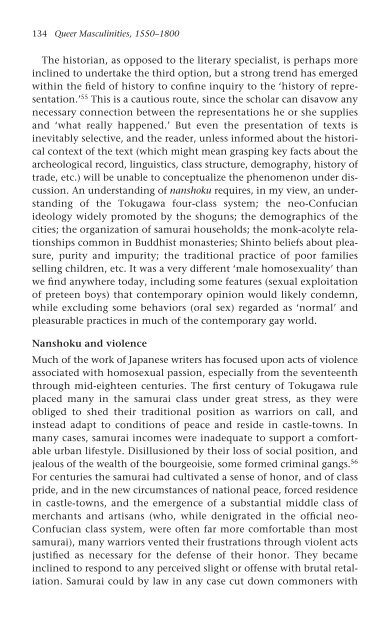queer masculinities
queer masculinities
queer masculinities
You also want an ePaper? Increase the reach of your titles
YUMPU automatically turns print PDFs into web optimized ePapers that Google loves.
134 Queer Masculinities, 1550–1800<br />
The historian, as opposed to the literary specialist, is perhaps more<br />
inclined to undertake the third option, but a strong trend has emerged<br />
within the field of history to confine inquiry to the ‘history of representation.’<br />
55 This is a cautious route, since the scholar can disavow any<br />
necessary connection between the representations he or she supplies<br />
and ‘what really happened.’ But even the presentation of texts is<br />
inevitably selective, and the reader, unless informed about the historical<br />
context of the text (which might mean grasping key facts about the<br />
archeological record, linguistics, class structure, demography, history of<br />
trade, etc.) will be unable to conceptualize the phenomenon under discussion.<br />
An understanding of nanshoku requires, in my view, an understanding<br />
of the Tokugawa four-class system; the neo-Confucian<br />
ideology widely promoted by the shoguns; the demographics of the<br />
cities; the organization of samurai households; the monk-acolyte relationships<br />
common in Buddhist monasteries; Shinto beliefs about pleasure,<br />
purity and impurity; the traditional practice of poor families<br />
selling children, etc. It was a very different ‘male homosexuality’ than<br />
we find anywhere today, including some features (sexual exploitation<br />
of preteen boys) that contemporary opinion would likely condemn,<br />
while excluding some behaviors (oral sex) regarded as ‘normal’ and<br />
pleasurable practices in much of the contemporary gay world.<br />
Nanshoku and violence<br />
Much of the work of Japanese writers has focused upon acts of violence<br />
associated with homosexual passion, especially from the seventeenth<br />
through mid-eighteen centuries. The first century of Tokugawa rule<br />
placed many in the samurai class under great stress, as they were<br />
obliged to shed their traditional position as warriors on call, and<br />
instead adapt to conditions of peace and reside in castle-towns. In<br />
many cases, samurai incomes were inadequate to support a comfortable<br />
urban lifestyle. Disillusioned by their loss of social position, and<br />
jealous of the wealth of the bourgeoisie, some formed criminal gangs. 56<br />
For centuries the samurai had cultivated a sense of honor, and of class<br />
pride, and in the new circumstances of national peace, forced residence<br />
in castle-towns, and the emergence of a substantial middle class of<br />
merchants and artisans (who, while denigrated in the official neo-<br />
Confucian class system, were often far more comfortable than most<br />
samurai), many warriors vented their frustrations through violent acts<br />
justified as necessary for the defense of their honor. They became<br />
inclined to respond to any perceived slight or offense with brutal retaliation.<br />
Samurai could by law in any case cut down commoners with


